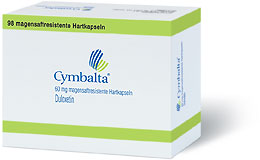SSNRI approved for the treatment of major depressive disorder Duloxetine
Lilly
Duloxetine is believed to exert its antidepressant effect through the potentiation of serotonergic and noradrenergic activity in the central nervous system. This selective serotonin and norepinephrine reuptake inhibitor (SSNRI) was approved on August 3, 2004, for the treatment of major depressive disorder (MDD).
Efficacy. Duloxetine was evaluated for the treatment of depression in 4 randomized, double-blind, placebo-controlled, fixed dose studies in adult outpatients aged 18 to 83 years (N=1059) meeting DSM-IV criteria for major depression. Patients were randomized to duloxetine 60 mg once daily or placebo for 9 weeks in 2 of the studies. In the third study, patients were randomized to duloxetine 20 or 40 mg twice daily or placebo for 8 weeks. In the fourth study, patients were randomized to duloxetine 40 or 60 mg twice daily or placebo for 8 weeks. Duloxetine demonstrated superior efficacy over placebo in all 4 studies as measured by improvement in the 17-item Hamilton Depression Rating Scale (HAMD-17) total score.
Safety. In patients receiving a serotonin reuptake inhibitor in combination with a monoamine oxidase inhibitor (MAOI), there have been reports of serious—sometimes fatal—reactions, including hyperthermia, rigidity, myoclonus, autonomic instability with possible fluctuations of vital signs, and mental status changes that include extreme agitation progressing to delirium and coma. It is recommended that duloxetine not be used in combination with an MAOI or within at least 14 days of discontinuing treatment with an MAOI. At least 5 days should be allowed after cessation of duloxetine therapy before initiation of therapy with an MAOI. Duloxetine should be avoided in patients with uncontrolled narrow-angle glaucoma since its use has been associated with an increased risk of mydriasis. Patients being treated with duloxetine or other antidepressants should be observed closely for clinical worsening and suicidality, especially at the beginning of a course of drug therapy, or at times of dose alteration. Concomitant use of duloxetine with inhibitors of CYP1A2 such as fluvoxamine and some quinolone antibiotics may result in elevated plasma levels of duloxetine; these combinations should be avoided. Duloxetine should not be administered with thioridazine due to the risk of serious ventricular arrhythmias and sudden death potentially associated with elevated plasma levels of thioridazine. Neonates exposed to serotonin reuptake inhibitors late in the third trimester have developed complications requiring prolonged hospitalization, respiratory support, and tube feeding. The potential risks and benefits of duloxetine therapy during the third trimester should be carefully considered. The most commonly observed adverse events associated with duloxetine therapy are nausea, dry mouth, constipation, decreased appetite, fatigue, somnolence, and increased sweating.
Dosing. Duloxetine should be administered at a total dose of 40 mg/d (given as 20 mg bid) to 60 mg/d (given either once a day or as 30 mg bid) without regard to meals. Patients should be periodically reassessed to determine the need for maintenance therapy and the appropriate dose for such therapy. Duloxetine should not be administered to patients with any hepatic insufficiency. When discontinuing duloxetine therapy, a gradual reduction in the dose is recommended rather than abrupt cessation in order to avoid the occurrence of discontinuation symptoms.
Refs
HOME
Resources
Drug Companies
Duloxetine: structure
Duloxetine (Cymbalta)
Depression and Chronic Pain
Health, Wealth and Happiness
The Futile Pusuit of Happiness?
Big Pharma and Madison Avenue
Happiness: a Buddhist Perspective
Happy Images Make Depressed People Sad
Duloxetine (Cymbalta): prescribing information (PDF)

